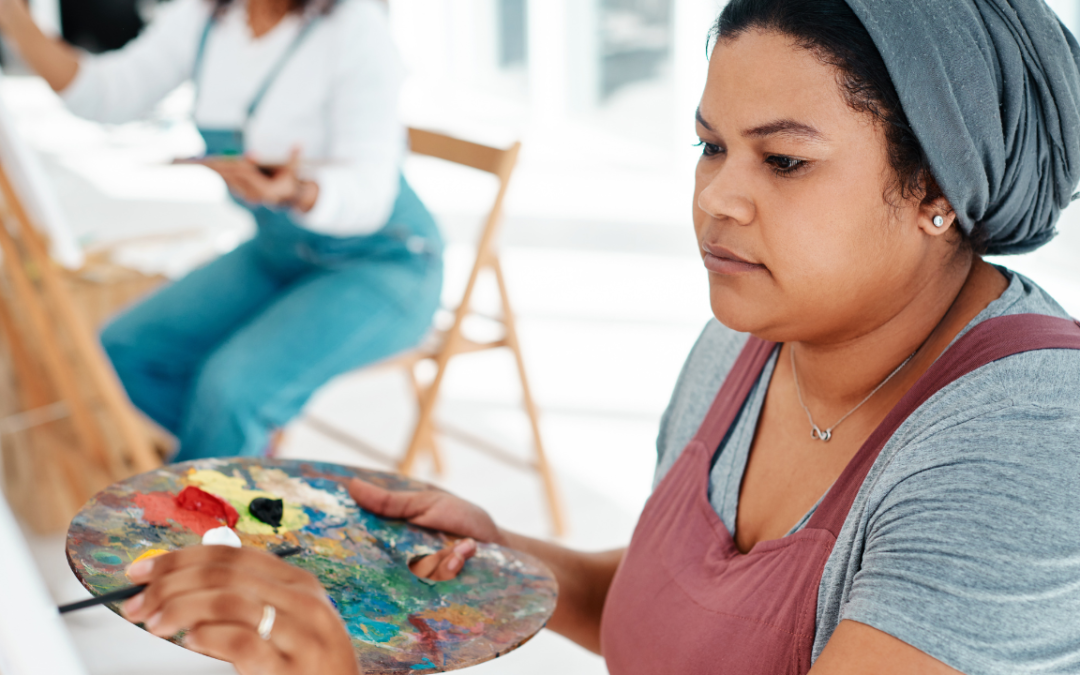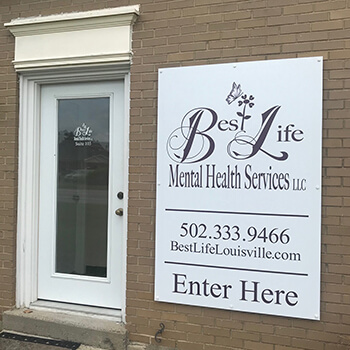It’s common for us to work on controlling the version of ourselves that we allow others to see. This can include hiding our true feelings and emotions to present the version of ourselves that we feel is most acceptable to society. It may feel like the right thing to do at the moment, but it may make it harder for you to acknowledge and process what you’re really feeling down the road. It’s also common for us to struggle to know what we’re feeling and how to communicate it after living through a difficult situation in life. Art therapy in Louisville allows us to explore, process, and communicate what we might not know how to do on our own.
As a Licensed Professional Art Therapist, I understand you probably have many questions about art therapy. Most people do, and I’m happy to answer them. But let me start off by addressing one of the most popular questions: Do I need to be good at art to try art therapy?
No. You don’t need any art skills to participate in and benefit from art therapy. In fact, I don’t consider myself a great artist. Artistic skill is not required. If you are an artist, great! If you can’t draw a stick figure, that’s great too! Don’t let your artistic ability or lack of hold you back from exploring how art therapy can help you. Let’s get started.
What is art therapy?
Art therapy is not about the end product. It’s not a paint-and-pour party or an art lesson; the goal is not to walk away with a beautiful piece of art to display in your house. The art part of art therapy is simply a tool used to help in the therapy process.
Sometimes it’s hard to come up with the words we need to describe our feelings. This can make it challenging to manage our feelings and move forward. I will lead you through activities chosen specifically with you in mind during art therapy sessions. Then, I will work with you to reflect on what you created to explore what your piece reveals about your thoughts, feelings, and emotions.
As an art therapist, I’m not looking to grade your creation or provide feedback about your art itself. Instead, I’m looking to see what your art says about you at that moment and what we can learn from it and apply to your therapy sessions and life.
Who can use art therapy?
The simple answer to this question is ANYONE. Art therapy is something that anyone can benefit from. However, there are some instances when the use of art therapy can be extra beneficial. This includes:
- Combat trauma survivors
- Victims of abuse
- Individuals who have experienced a natural disaster
- Those who have been diagnosed with things like cancer, disabilities, or traumatic brain injury
- People with autism
- Those working to overcome addiction
- People struggling with anxiety or depression
While these are some examples of who can benefit from art therapy, there is no all-inclusive list. Art therapy can benefit those who are looking to improve interpersonal skills or reduce stress. It can also be beneficial for those who struggle to find the words to communicate what they have experienced and how they feel.
You don’t have to experience a certain situation, receive a certain diagnosis, or reach a certain level of trauma to try art therapy. Maybe you’re feeling stuck in life right now or are exhausted from feeling like your emotions are hard to control; art therapy is for you too!
If you’re still wondering how art therapy can help in different situations, check out these art therapy videos, which share the benefits of art therapy in situations such as children’s hospitals, eating disorders, addiction, memory care, and more.
What are the benefits of art therapy?
The American Art Therapy Association shares that “Art therapy is used to improve cognitive and sensorimotor functions, foster self-esteem and self-awareness, cultivate emotional resilience, promote insight, enhance social skills, reduce and resolve conflicts and distress, and advance societal and ecological change.”
The benefits you’ll experience from art therapy sessions will vary based on your goals. And it’s perfectly okay if you’re unsure what your goals are when you first show up. This is something we can work on establishing together.
Art therapy helps you communicate without feeling the pressure to find the right words. It can help with things like:
- Processing grief
- Self-discovery
- Building self-esteem
- Emotional release
- Managing anxiety and depression
- Processing trauma
And the best part is that all you need to do is engage in the activity. My training has taught me to understand what role different art mediums can play throughout therapy sessions and how your use of them can reveal your thoughts, feelings, and emotions. We will work together through art to help you reach your therapy goals.
How does art therapy work?
Art therapy’s creative processes can help you acknowledge and recognize your feelings, even those you’ve been unaware of. The process can also help you build confidence and experience feelings of accomplishment when you’ve finished an activity. Art therapy provides you with a safe space to release the emotions you’ve been holding onto.
Sometimes there just aren’t words to describe the sadness, overwhelm, confusion, or other feelings we’re experiencing. Being able to get in touch with those emotions and communicate them through art, instead of words, can help us better understand ourselves and release those emotions in a healthy way.
During sessions, we may use any of the following art mediums or activities:
- Drawing
- Painting
- Writing
- Clay modeling
Here is an example of an art therapy activity:
What does an art therapy session look like at Best Life Mental Health Services?
I understand that fear of the unknown can be overwhelming, so I want to share with you what a typical art therapy session with me might look like.
An art therapy session is typically 50-55 minutes long. I like to start with a check-in, such as how your week has been, what’s new, and how you feel. From there, depending on your goals in therapy or what is going on in your life, I will give you a directive/instructions using the materials I see most fit, or sometimes you will get to choose your own!
While you create art for about 20-25 minutes, we can talk, listen to music, or sit silently; it’s up to you. After you finish, we will process and discuss what you made, how it felt, and any insights you made. When you leave you can take your art with you, throw it in the trash, burn it, leave it with me, or whatever feels right.
In addition to being trained as an art therapist, I’m also in process of being trained in EMDR (Eye Movement Desensitization and Reprocessing) and traditional forms of psychotherapy. I will work to personalize therapy sessions to your unique situation and use the treatments that will best serve you and your therapy goals.
If you’re interested in trying art therapy in Louisville, you can schedule a free consultation here.



